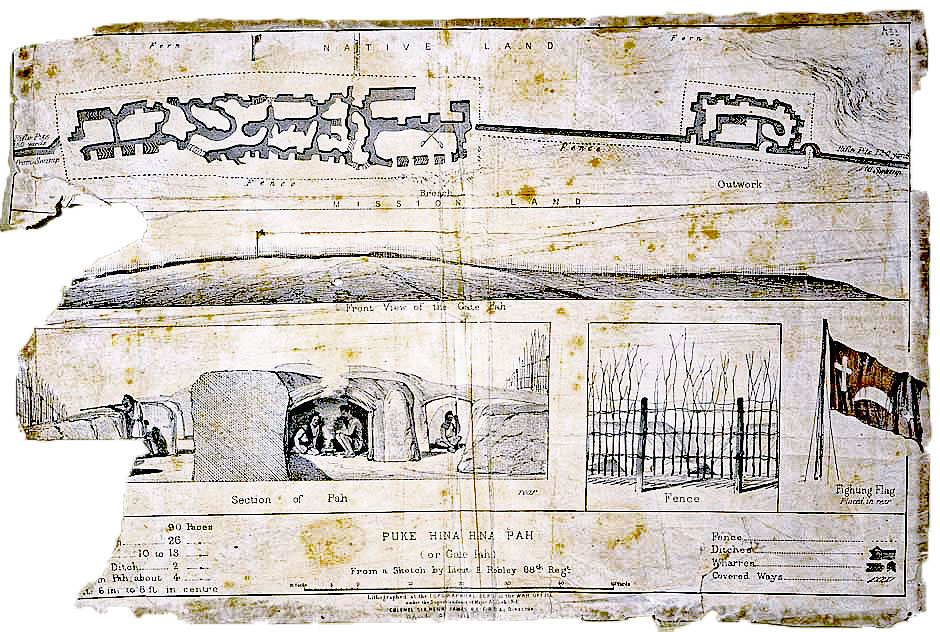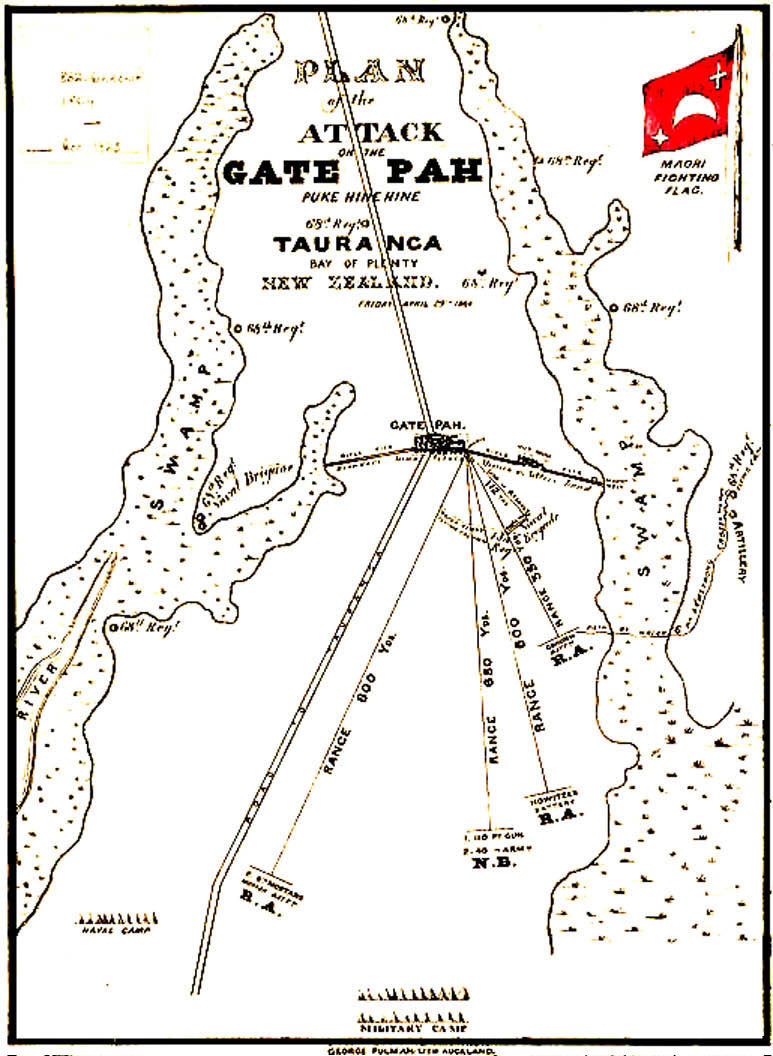|
Maori songs - Kiwi songs - Home In 1864, 230 Maori defenders dug themselves into the hilltop at Puke-hinahina near Tauranga awaiting the heaviest artillery bombardment the British army had ever delivered. In the ensuing battle, the 1700 British attackers were crushingly defeated.
The Battle of PukehinahinaThe Government sent troops to the Tauranga district in January 1864, to incite Maori there into fighting, so that land could then be confiscated. In response, the Ngai-te-Rangi built a strong position on the Pukehinahina ridge about 2 miles from Tauranga. The site chosen was at a gate in the boundary fence between missionary and Maori land and so it came to be called “Gate Pah”.On 27 April 1864 General Cameron moved his force to Pukereia Hill about 1,200 yards from the defenders' position. The force comprised a Naval Brigade from the Esk, Miranda, and Falcon; elements of the Royal Artillery 43rd and 68th Regiments; and a movable column of officers and men from the 12th, 14th, 40th, and 65th Regiments, making 1,695 officers and men in all. In order to cut off the Maoris' possible line of retreat, Cameron dispatched the 68th Regiment to occupy the narrow neck of land between two swamps, at the rear of the pa. At daybreak on 29 April Cameron began shelling the pa and eight hours later the shells had opened a breach in the defence works. He mounted a strong assault through this breach, but the defenders targeted the officers, and the leaderless attackers were repulsed with heavy losses.  As it was too late in the day for a further attack, Cameron decided to renew the battle the next morning. During the night, however, small parties of Maoris, taking their wounded with them, slipped through the 68th Regiment's lines to safety. British casualties in the engagement were 111 killed and wounded, while the Maoris lost 25 killed and an unknown number wounded. Gate Pa was the scene of the strongest artillery barrage mounted during the Maori Wars.
The Pārua at PukehinahinaThe defences were designed by Pene Taka Tuaia, who is said
to have learnt his military engineering during the Northern
War of 1845–46. As well as constructing a palisade fence or
pā for stopping enemy with hand weapons, and a wattle fence
or pekerangi to conceal further defences, he made extensive
use of anti-artillery bunkers (rua) and of concealed
trenches to lull the British into a false sense of security
when they stormed it. Numerous bunkers were prepared instead
of several large ones, so that casualties would be minimal
should artillery fire breach one of them.
After eight hours of British artillery fire, no more than 15 defenders had been killed. The British were so impressed by the genius of this design, they made careful copies of its features, and built the same structures in the 1914-1918 World War. 
Alien WeaponryA three-piece thrash metal band from Waipu, New Zealand, formed in 2010 by brothers Henry and Lewis de Jong. The band consists of Lewis de Jong (b. 2002, guitar and vocals), Henry de Jong (b. 2000, drums), and Ethan Trembath (b. 2003, bass guitar). The great great great grandfather of Henry and Lewis, Te Ahoaho, lost his life in the battle of Pukehinahina. Maori is songwriter Lewis's first language and both he and Henry attended Kura Kaupapa Maori. The band has been performing in Te Reo since 2015. SongwritingLewis "I'll come up with a riff and
Henry'll start playing the drums and Ethan will follow along
with bass. If we hear something that clicks, we'll usually
press 'record' on a little recorder we have. We have a
massive list of stuff we've come up with jamming. Organising
the structure's one of the hardest parts; it can be quite
tedious working out four bars of this, eight bars of that.
After we work out the structure, I usually dig through some
lyrics I already have, or I write them. We listened to all
sorts of music when we were younger, but we were drawn to
thrash metal because it’s quite complex music, and it is a
great vehicle for expressing real stories and emotions.” |

